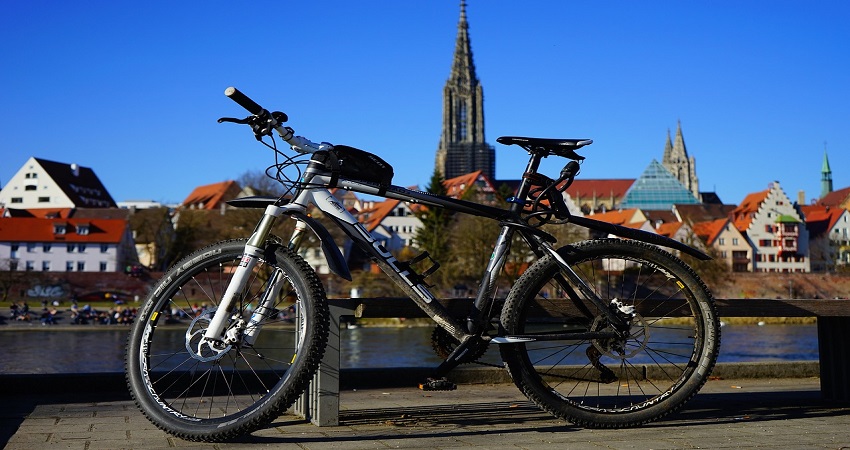Yes, mountain bike handlebars can be raised by adjusting the stem or using spacers to increase the height. Adjusting the stem or adding spacers allows riders to customize the handlebar height to their preference, providing a more comfortable and ergonomic riding position.
Raising mountain bike handlebars is a common practice among cyclists looking to enhance their biking experience. By adjusting the stem or adding spacers, riders can achieve a more upright riding position, reducing strain on the back and improving comfort during long rides.
This customization option allows cyclists to fine-tune their bike’s handlebar height to match their riding style and physical dimensions. Whether it’s for recreational biking or competitive mountain biking, the ability to raise handlebars provides an opportunity for riders to achieve optimal comfort and performance on their mountain bikes.
Exploring The Adjustability Of Mountain Bike Handlebars
Mountain biking enthusiasts often seek ways to optimize their riding experience, and one fundamental aspect of this pursuit is the adjustability of the handlebars. The handlebar height plays a crucial role in comfort, control, and overall performance on the trail. In this comprehensive guide, we delve into the adjustability of mountain bike handlebars, focusing on the potential benefits of raising the handlebars and the significance of handlebar height.
The Importance Of Handlebar Height
Optimal handlebar height is a critical factor in achieving a comfortable and efficient riding position. When the handlebars are positioned at the right height, it promotes proper posture, reduces strain on the wrists and back, and enhances overall control and maneuverability. Whether you are tackling technical descents or powering through challenging climbs, the appropriate handlebar height can significantly impact your riding experience.
Advantages Of Raising Mountain Bike Handlebars
- Improved Comfort and Control: Raising the handlebars can alleviate strain on the upper body and provide a more relaxed riding position, especially during long rides. This adjustment can also enhance stability and control, particularly when navigating challenging terrain and obstacles.
- Enhanced Maneuverability: By raising the handlebars, riders can achieve a more upright position, allowing for better visibility of the trail ahead. This improved line of sight facilitates quicker reactions and better decision-making when encountering obstacles, enhancing overall maneuverability.
- Reduced Fatigue: A higher handlebar position can help reduce fatigue, as it minimizes the amount of weight placed on the hands and upper body. This can be particularly beneficial for riders tackling extended rides or demanding off-road trails, leading to a more enjoyable and sustainable riding experience.
Methods For Raising Mountain Bike Handlebars
When it comes to finding the perfect fit on your mountain bike, handlebar height plays a crucial role in ensuring comfort and control. If you find yourself needing to raise your handlebars to achieve a more upright riding position or to alleviate strain on your back and wrists, there are a few methods you can try.
In this article, we will explore two popular options for raising mountain bike handlebars: using steering tube spacers and installing handlebar risers.
Using Steering Tube Spacers
Steering tube spacers are a simple and effective way to raise your mountain bike handlebars. These spacers are often included in bike assembly kits and can be easily installed without the need for any special tools. Here’s how it’s done:
- Start by loosening the stem bolts using an Allen wrench. This will allow you to adjust the height of the handlebars.
- Once the stem bolts are loose, carefully slide the spacers onto the steering tube above the stem.
- Arrange the spacers in your desired configuration to raise the handlebars to the desired height. Make sure to evenly distribute the spacers for stability.
- Tighten the stem bolts back up, ensuring that the handlebars are secure and aligned properly.
- Finally, take your bike for a test ride to ensure the new handlebar height feels comfortable and provides the desired riding experience.
Installing Handlebar Risers
If you require a more significant increase in handlebar height, installing handlebar risers might be the solution for you. Handlebar risers are aftermarket components that attach to your bike’s handlebars and provide an extra elevation.
Here’s how you can install handlebar risers:
- Begin by removing the existing handlebar grips and any accessories attached to the handlebars.
- Using an Allen wrench, loosen the bolts on the handlebar stem and remove the handlebars from the bike.
- Attach the handlebar risers to the handlebars, aligning them with the existing stem holes.
- Securely tighten the bolts on the handlebar risers, ensuring they are firmly attached to the handlebars.
- Slide the handlebars back into the stem and align them with the desired angle and height.
- Tighten the stem bolts, making sure the handlebars are secure and properly aligned.
- Reinstall the handlebar grips and any accessories you removed earlier.
- Take your bike for a test ride to assess the new handlebar height and make any necessary adjustments.
By utilizing these methods for raising mountain bike handlebars, you can achieve a more comfortable and personalized riding position. Remember to always prioritize safety and take the time to ensure that your handlebars are secure and properly aligned before hitting the trails.
Practical Demonstrations And Tips
Raising the handlebars on your mountain bike can significantly improve comfort and control, especially if you find yourself experiencing discomfort or back pain during your rides. In this section, we will provide you with practical demonstrations and tips on how to raise your handlebars effectively.
Tutorial: How To Raise Handlebars On An MTB
If you’re wondering how to raise the handlebars on your mountain bike, don’t worry! It can be easily done with the help of spacers. Follow this step-by-step guide to adjust the handlebar height on your MTB:
Step-by-step: Raising Handlebars With Spacers
To raise the handlebars on your mountain bike using spacers, follow these simple steps:
Step 1: Gather the necessary tools:
- Bike stand or a secure resting position for your bike
- Allen wrench or hex key set
- Headset spacers (if needed)
Step 2: Secure your bike:
Place your mountain bike on a bike stand or at a secure resting position to ensure stability while making adjustments.
Step 3: Loosen the stem:
Using the appropriate allen wrench or hex key, loosen the screws on the stem bolts. Make sure to loosen them gradually and evenly to avoid damaging the bolts.
Step 4: Adjust the spacers:
If you want to raise the handlebars, you can add spacers between the stem and the headset. Place the spacers on top of the stem or below it, depending on your preference. Adding more spacers will result in a higher handlebar position. Remember to consider the maximum allowed height for the stem and handlebar setup to ensure safety.
Step 5: Reattach the stem:
Once you have adjusted the spacers to your desired height, reattach the stem to the steerer tube and tighten the bolts gradually and evenly. Make sure the stem is aligned with the front wheel to maintain proper handling.
Step 6: Test the adjustment:
Before taking your mountain bike for a ride, it’s crucial to test the handlebar adjustment. Sit on the bike and ride it to ensure the new handlebar position feels comfortable and doesn’t strain your wrists, back, or neck. If needed, make further adjustments until you find the optimal height.
Raising the handlebars on your mountain bike can greatly enhance your riding experience. It allows for a more upright riding position, relieving stress on your back and neck during long rides. Remember to follow these steps carefully to ensure a proper and secure adjustment.
Tools And Equipment Required
Raising the handlebars on your mountain bike can significantly improve your riding experience, but it requires the right tools and equipment. Whether you’re looking to increase comfort or address a medical condition, understanding the process and having the essential tools is crucial.
Essential Tools For Adjusting Handlebar Height
When it comes to adjusting your handlebar height, the following essential tools are required:
- Allen keys
- Adjustable wrench
- Steering tube spacers
- New stem (optional)
Understanding The Purpose Of Steering Tube Spacers
Steering tube spacers play a crucial role in adjusting handlebar height. They are used to customize the spacing between the stem and the headset. By adding or removing spacers, you can effectively alter the height of your handlebars to achieve the desired riding position.
Common Questions And Faqs
To adjust mountain bike handlebars, you can raise them by installing a stem riser or adding spacers for increased height. Refer to tutorials for step-by-step instructions on how to raise handlebars effectively and ensure a comfortable riding position.
Can You Increase Handlebar Height On A Trek Mountain Bike?
Yes, it is possible to raise the handlebars on a Trek mountain bike by adjusting the stem height or replacing it with a longer one.
Do I Need Additional Spacers To Raise My Handlebars?
If your handlebars are not adjustable, you may require additional spacers or a longer stem to raise them to your preferred height.
Exploring Handlebar Adjustments In Different Scenarios
Looking to adjust your mountain bike handlebars? Wondering if you can raise them? Learn how to tweak your handlebar height for different scenarios with simple DIY tips and tools. Experiment with stem adjustments and bar risers to find the perfect setup for your ride.
Adjusting Brake Levers On Mountain Bikes
Adjusting brake levers allows for better control and comfort during rides.
- Ensure levers are easily reachable with a relaxed hand position.
- Make adjustments to match your hand size and riding style.
Impacts Of Handlebar Height On Riding Performance
Handlebar height can significantly affect your riding performance.
- Higher handlebars provide a more upright riding position, ideal for comfort.
- Lower handlebars offer improved aerodynamics and handling on technical terrains.
In different scenarios, adjusting your mountain bike’s handlebars can enhance your overall riding experience. Whether it’s fine-tuning brake levers or optimizing handlebar height, these adjustments play a crucial role in comfort, control, and performance during your mountain biking adventures.
Challenges Faced When Raising Handlebars
If you’re considering raising the handlebars on your mountain bike, there are a few challenges to keep in mind. Addressing these challenges ensures a smooth and effective adjustment to enhance your riding experience.
Potential Limitations Of Adjusting Handlebar Height
- Risks of over-tightening the stem bolts
- Incompatibility of stem and steerer tube dimensions
- Limited adjustability due to shorter steerer tube length
- Lack of sufficient headset spacers
Solutions For Overcoming Handlebar Adjustability Issues
- Regularly inspect and maintain proper torque on stem bolts
- Consult a professional for compatible stem and steerer tube specifications
- Consider replacing the fork with a longer steerer tube for increased adjustability
- Ensure availability of necessary headset spacers for desired height adjustment
Exploring Innovations In Handlebar Adjustability
Exploring innovations in handlebar adjustability, one may wonder if mountain bike handlebars can be raised. Luckily, there are various methods such as using stem risers, spacers, or even replacing the stem itself to achieve the desired height. With a few tools and adjustments, bikers can customize their handlebar height for optimal comfort and performance.
Modern Techniques For Modifying Handlebar Height
Adjusting the handlebar height on a mountain bike is crucial for achieving proper comfort and control during your rides. Fortunately, with modern advancements, it is now possible to modify handlebar height to suit your preferences and riding style.
One popular technique for modifying handlebar height is by using adjustable stems. These stems allow you to raise or lower the handlebars by adjusting the angle of the stem. By loosening the bolts on the stem, you can easily reposition the handlebars to a more comfortable height. This method is especially convenient if you often switch between different riding terrains or simply want to experiment with different handlebar heights.
Another innovative technique is the use of handlebar risers. These are specially designed components that sit above the stem and add height to the handlebars. Handlebar risers come in various shapes and sizes, allowing you to find the perfect amount of elevation for your riding needs. They are commonly used by mountain biking enthusiasts who require a more upright riding position or want better maneuverability on technical trails.
Additionally, advancements in bike technology have introduced adjustable handlebar systems. These systems feature integrated mechanisms that enable you to change the handlebar height with ease. Some systems even allow you to adjust the handlebar angle, giving you complete control over your riding position. These innovative solutions have revolutionized handlebar adjustability, providing riders with a range of options to optimize their comfort and performance.
Handlebar Riser Options For Mountain Biking Enthusiasts
If you’re a mountain biking enthusiast looking to raise your handlebars, various handlebar riser options are available to cater to your specific needs. Here are some popular choices:
| Handlebar Riser Option | Key Features |
|---|---|
| Handlebar Riser Extensions | Attaches to the handlebars to raise their height by a few centimeters. |
| Adjustable Rise Stems | Allows for both handlebar height and angle adjustments for a customizable riding position. |
| Aero Handlebar Riser Kits | Designed for aerodynamic mountain bikes and provide a more comfortable riding position by raising the handlebars. |
These handlebar riser options offer flexibility in adjusting the height and angle of your handlebars, allowing you to find the perfect fit for your riding style. Remember, it’s always important to choose components that are compatible with your bike’s specifications and consider seeking professional assistance if you’re unsure about making adjustments yourself.
In conclusion, advancements in handlebar adjustability have made it possible to modify the height of mountain bike handlebars to suit individual preferences. From adjustable stems to handlebar risers, there are various modern techniques and options available that allow riders to customize their riding experience and optimize their comfort and performance.
Frequently Asked Questions
Can You Make Mountain Bike Handlebars Higher?
Yes, you can raise mountain bike handlebars by installing a stem extender or adding spacers.
How High Should My Mountain Bike Handlebars Be?
For optimal comfort and control, adjust mountain bike handlebars to a height that puts wrists in a neutral position.
Can You Raise The Handlebars On A Trek Mountain Bike?
Yes, you can raise the handlebars on a Trek mountain bike. You may need additional spacers or a longer stem for adjustment.
Do I Need Spacers To Raise Handlebars?
To raise handlebars, additional spacers or a longer stem will be needed if the handlebars are not adjustable. Changing the stem to one with an angle can also help achieve a limited height gain.
Conclusion
After exploring various methods and factors to consider, it’s clear that mountain bike handlebars can indeed be raised. From adjusting headset spacers to installing a new stem, there are several practical ways to achieve the desired handlebar height. However, it’s essential to ensure proper installation and compatibility with the bike’s components for a safe and comfortable ride.




